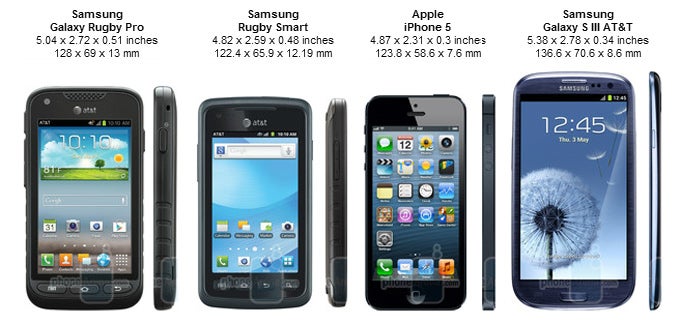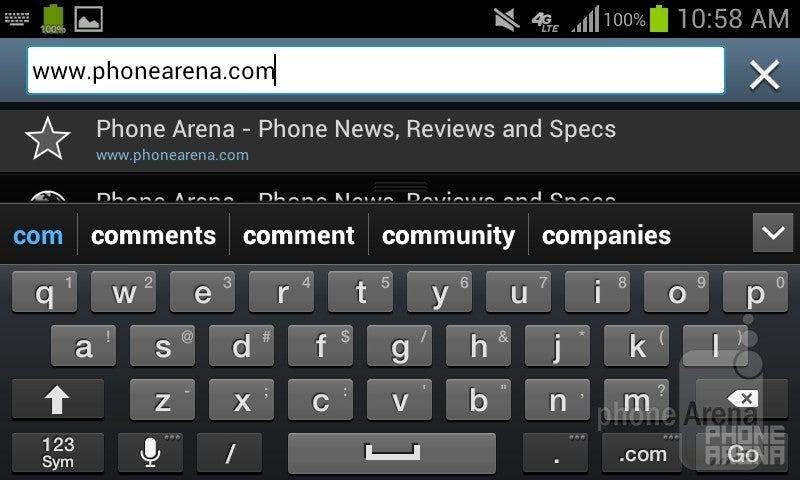Samsung Galaxy Rugby Pro Review

Introduction:
Earlier this year, we saw the Samsung Rugby Smart come to AT&T, which set it apart from other smartphones with the carrier, as it was designed to be a rugged Android device. Now eight months later comes the follow-up, the Samsung Galaxy Rugby Pro – it has a larger 4” display, 1.5GHz dual-core Snapdragon S4 processor, and is running Android 4.0.4 Ice Cream Sandwich. If that wasn’t enough, 4G LTE is also on-board, so you can get faster data connection while in an AT&T LTE coverage area. Add all of that together, and you have a smartphone that has a nice appeal to it with only a $100 on-contract price.

Included in the retail box is the Samsung Galaxy Rugby Pro SGH-I547 smartphone, 1850mAh battery, wall charger with detachable microUSB cable, and user guides.
Design:
The overall design of the Samsung Galaxy Rugby Pro hasn’t changed too much from the Rugby Smart. It still exhibits all the qualities of a rugged device, with thick rubber gripping on the sides, and a textured locking battery cover. This does make the device feel a bit chunky in the hand, but no more so than a standard smartphone with an add-on case installed.

You can compare the Samsung Galaxy Rugby Pro with many other phones using our Size Visualization Tool.
Since the Galaxy Rugby Pro meets military standard 810F, it is resilient to blowing rain and sand, high humidity, thermal shock, and is waterproof up to 1 meter for 30 minutes. The display and front keys also have an anti-scratch coating on them. We were able to drop the phone several times (on tile) from a height of 5 feet, and there were no visible signs of damage to the device.

Located on the back is a 5MP autofocus camera with LED flash. The battery cover is locking, but doesn’t require too much effort with a finger nail to turn the latch to unlock it. When removed, there is a rubber seal that protects the 1650mAh battery, SIM card, and microSD memory card slot from damage.
Display:
Even though the Samsung Galaxy Rugby Pro is built to withstand the elements, it remains a mid-range smartphone, but we're glad to see that the display size has increased from 3.7” to 4”, though the resolution remains WVGA 480x800 pixels. This means that small text appears slightly jagged at times. But since it is Super AMOLED, it provides eye-grabbing colors and excellent contrast when viewing images or watching videos. One feature missing is any type of automatic backlight brightness setting, which means that you have to manually set the screen brightness yourself. This can be annoying when going from a dark environment to outside in the sun, as you’ll have to keep adjusting the backlight. The only work around is to set it near the middle, so it wouldn’t need readjusting too often.
Interface and Functionality:
We’re pleased to see that this time around the Samsung Galaxy Rugby Pro comes running Android 4.0.4 Ice Cream Sandwich, and layered over it is the familiar Samsung TouchWiz user interface, similar to what we’ve seen on the Samsung Galaxy S III. You are still presented with the 7 home screen experience, with 5 static quick-launch icons on the bottom, horizontal scrolling app drawer, and a variety of TouchWiz widgets. Even though it is easy to use and allows for some personalization, it doesn’t have any type of themes, like what we’ve seen on HTC smartphones with their Sense UI.

There’s nothing new with the device’s core set of organizer apps, but that doesn’t stop us from being content by it. For example, it offers the same E-Mail and Gmail experience found with all other Android smartphones – so yeah, it’s good enough for most things without too much complications.
As with other smartphones on AT&T’s lineup, it’s stacked to the roof with the normal set of preloaded apps – though the carrier makes sure its presence is known. Specifically, we find AT&T Code Scanner, AT&T FamilyMap, AT&T Navigator, AT&T Locker for Cloud Storage, AT&T Smart Wi-Fi, AT&T U-Verse Live TV, and myAT&T account manager. As for other third party apps, they consist of AllShare Play, Amazon Kindle, INRIX Traffic, Qik Lite, YPmobile, and Polaris Viewer to open Microsoft Office and Adobe Acrobat files.
Processor and Memory:
One main improvement over the Samsung Rugby Smart and its 1.4GHz single-core processor is that the Samsung Galaxy Rugby Pro comes with a faster 1.5GHz dual-core Snapdragon S4 processor, as well as 1GB of RAM instead of only 512MB. This means the device has plenty of power to handle pretty much any app you can through at it, and doesn’t feel sluggish at all when multitasking or moving through the home screens and app drawer. Though, it is not a speed demon like the newest set of smartphones with quad-core processors.
| Quadrant Standard | AnTuTu | NenaMark 2 | |
| Samsung Galaxy Rugby Pro | 4855 | 6730 | 60,5 |
| Samsung Galaxy S III | 5022 | 6831 | 58,7 |
| LG Optimus G AT&T | 7669 | 11245 | 60,1 |
| HTC One X+ | 7244 | 13439 | 56,7 |
The internal storage also gets a nice increase to 8GB, though there is only 5GB available to the user out-of-the-box. If this is not enough, you can always add a microSD memory card for up to 32GB of additional storage.
Internet and Connectivity:
With 4G LTE on board, as well has HSPA+, you’re pretty much covered when it comes to 4G data connections. We’re overall impressed by the web browsing performance of the smartphone, since it’s able to exhibit the responsiveness of some high-end devices. Specifically, pinch-to-zoom and kinetic scrolling are accompanied with smooth movements that don’t stutter even with Flash content. To sum it up, even though this is mid-range device, its web functions performs quite well.
When testing out AT&T’s 4G LTE in our area of South FL, the Samsung Galaxy Rugby Pro with the SpeedTest.net app was able to accomplish between 6.75-26.79Mbps downloads and between 1.09-7.46Mbps uploads, depending on the location and time of day. If you are not in a 4G LTE area, the device can use HSPA+, or even EDGE if need be. It is also able to work with variety of GSM networks, including quad-band 850/900/1800/1900MHz and UMTS tri-band 850/1900/2100MHz.
Camera:
Unfortunately, one area that did not get improved is the camera, as we’re presented with probably the same 5MP shooter that was on the Samsung Rugby Smart. Even though most images that we took outside look pleasing and have plenty of detail, occasionally the auto white balance had difficulties and gave images a blue hue. When using the camera inside, even with plenty of light, images look soft and blurry, with plenty of grain being visible. The LED flash is bright enough for taking a picture in the dark, but again you have the blue hue problem.
Recording videos remain limited to 720p resolution, but does have 30 frames-per-second. We wouldn’t mind the 720p resolution, but colors are blotchy and there are plenty of artifacts that get in the way of making the video look good. Even though this is a mid-range phone, we would like to see better.
Samsung Galaxy Rugby Pro Sample Video:

Multimedia:
For listening to music, we have the same TouchWiz music player that is used by most Samsung devices, but there is plenty of functionality at its core. With the rear speaker, it’s rather average with its tone quality and volume, but there are various equalizer settings to better attune it to specific genres of music. Of course you can always plug-in a set of wired headphones, or use a wireless Bluetooth headset for improved music quality.
The device is capable of playing 720p videos and supports popular formats, including MPEG-4, H.246, DivX, and Xvid; though we were most enchanted by the saturated and punchy colors from its Super AMOLED panel. Aside from that, the experience is still worthwhile thanks to its smooth playback and overall great quality.

Call quality is generally good with the Samsung Galaxy Rugby Pro, as voices on our end sounded clear and natural, but turning the volume up past medium presented some buzzing/rattling sound in the earpiece speaker – which we also heard while using the rear speakerphone at high volumes. Even though people that we called said that we sounded natural on their end, they could tell we were using a cell phone.
The signal quality was also good, as we didn’t drop any calls, and 4G LTE data remained connected in our area with a signal of -89dBm.
Battery:
With all of this, it is unfortunate that the device is limited to a mediocre 1850mAh battery, which was only able to provide us up to 8 hours of talk time, or about 16 hours of mixed usage on a single charge.
Conclusion:
When it comes right down to it, the Samsung Galaxy Rugby Pro has a lot to offer, especially since it carries a reasonable $100 on-contract price. Its design and construction make it ideal for those individuals that need or require a rugged smartphone that can withstand more than the average abuse, and can keep out Mother Nature. Combined with the 4” Super AMOLED display and dual-core Snapdragon S4 processor, it can also conquer pretty much any task you can throw at it.
Software of reviewed unit:
Android 4.0.4
Baseband version I547UCLI3
Build number: IMM76D.I547UCALI3











Things that are NOT allowed: